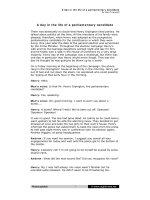Bài luận tiếng anh 3 docx
Bạn đang xem bản rút gọn của tài liệu. Xem và tải ngay bản đầy đủ của tài liệu tại đây (249.62 KB, 11 trang )
22
August: “To cut down on forex smuggling,” all Chinese and non-Chinese residents are
required to get the SAFE’s approval before taking large amounts of foreign currency
abroad.
August: FIEs were allowed to use foreign exchange settlements accounts as time
deposits. In addition, they were allowed to obtain renminbi loans backed by foreign
exchange collateral.
2000:
February: The SAFE and the General Customs Administration forbid trade firms from
purchasing hard currency to pay for certain categories of imports.
2001:
September: The SAFE lifted the ban on the purchase of foreign exchange for
repayment of past overdue debts . Restrictions on purchasing foreign exchange for
advance repayment of domestic foreign-currency denominated debts were relaxed.
November: A more generous foreign exchange policy was adopted toward individuals
paying for their study abroad. According to the previous regulations, individuals paying
for their own study abroad could only convert their first year tuition and living expenses
into foreign exchange, whereas the new rule permitted them to convert all tuition and
living expenses needed throughout the period of study.
2002:
October: All enterprises with foreign trading rights including domestically-funded
enterprises (DFEs) and foreign-funded enterprises (FFEs) became eligible to establish
foreign exchange accounts for current international transactions.
December: Foreign-funded banks were allowed to engage in buying and selling of
foreign exchange with DFEs.
2003:
March: Beijing, Tianjing, Sichuan, Heilongian and other 10 provinces started
experiments to relax Chinese firms’ overseas FDI requirement. Renminbi assets can be
used to exchange foreign currency for FDI purposes. Overseas investment under $30
million can be approved by local SAFE branches in the 10 provinces/municipalities that
were first to experiment with the relaxation of external investment.
May: If a payment made by the foreign currency credit card exceeds the foreign
currency deposit, the difference can be paid using the renminbi.
23
May: Certain qualified foreign institutional investors (QFIIs) were allowed to invest in
A-shares in China.
June: Chinese outward processed trade investment under $30 million can be approved at
the provincial level of the SAFE.
August: Multinational corporations’ non-trade related payments are allowed to be
conducted using either foreign currency or renminbi.
September: The surrender requirement was canceled for certain current account foreign
exchange earnings such as international engineering contract, labor contract, international
shipping and fees and fees from shipping services.
September: Residents and non-residents can bring in or take out up to $5000 per person.
Domestic residents for overseas travel can carry up to $5000 in cash per person.
October: New measures were issued to allow multinational corporations to conduct
cross-border foreign exchange management. They include: (1) allowing eligible
multinational corporations (MNCs) to use foreign exchange funds in China to meet their
foreign exchange needs overseas; (2) allowing eligible MNCs to lend foreign exchange
from their operations in China to their foreign affiliates; (3) foreign exchange transactions
among subsidiaries of MNCs in China no longer need approval from the SAFE. Such
transactions can be carried out using banks.
November: The system of collecting deposits that guarantee profits from investment
abroad has been canceled.
November: China agreed to provide clearing arrangements for banks in Hong Kong to
conduct personal renminbi business on a trial basis. The scope of renminbi business to be
offered will be confined to transactions that facilitate personal spending but do not
involve investment and other capital account transactions. The scope of the renminbi
business include the following four areas. (1) Deposit taking services from Hong Kong
residence. (2) Exchange of renminbi to Hong Kong dollars and vice verse. (3)
Remittances by holders of renminbi deposit accounts in Hong Kong of renminbi funds to
their accounts in Mainland. (4) Use by Mainland residents of their renminbi debit and
credit cards issued by Mainland for spending in Hong Kong. Participating banks or their
subsidiaries may also issue renminbi debit or credit cards to residents of Hong Kong for
use on the Mainland.
2004:
September: The experiment to relax investment abroad under $30 million was expanded
to 23 provinces/municipalities. It is estimated that 510 Chinese firms that took the
opportunity invested $2.1 billion in 2003—an increase of 112.3 percent (SAFE,
September 10, 2004).
24
2005:
January: The amount of the renminbi in cash that can be taken out or into China was
raised from 6,000 yuan per person to 20,000 yuan per person.
February: China relaxed controls on foreign exchange earning retention on tow fronts.
(1) Companies are allowed to retain foreign exchange earnings above the limits up to 90
days, as opposed to the previous limit of 10 days. (2) The official limits are raised to
100 % of foreign exchange earnings from the previous limits of 30% to 50% for firms
that apply for higher limits. Local offices of the SAFE are given the authority to approve
such increases in the limits.
25
Appendix II
Date Description and Sources
Data on spot and three months forward exchange rates for the renminbi, the U.S. dollar,
the Hong Kong dollar and three months deposit rates on the renminbi, the U.S. dollar and
the Hong Kong dollar are daily observations during 1999-2004. They are obtained from
the CEIC, the People’s Bank of China, the Bank of China, the Hong Kong Monetary
Authority.
Data on trade (exports plus imports) and errors and omissions are from the State
Administration of Foreign Exchange.









